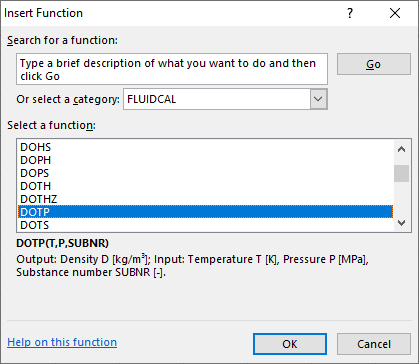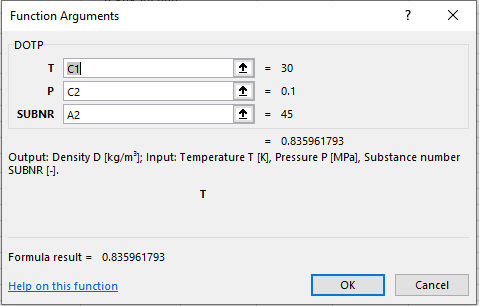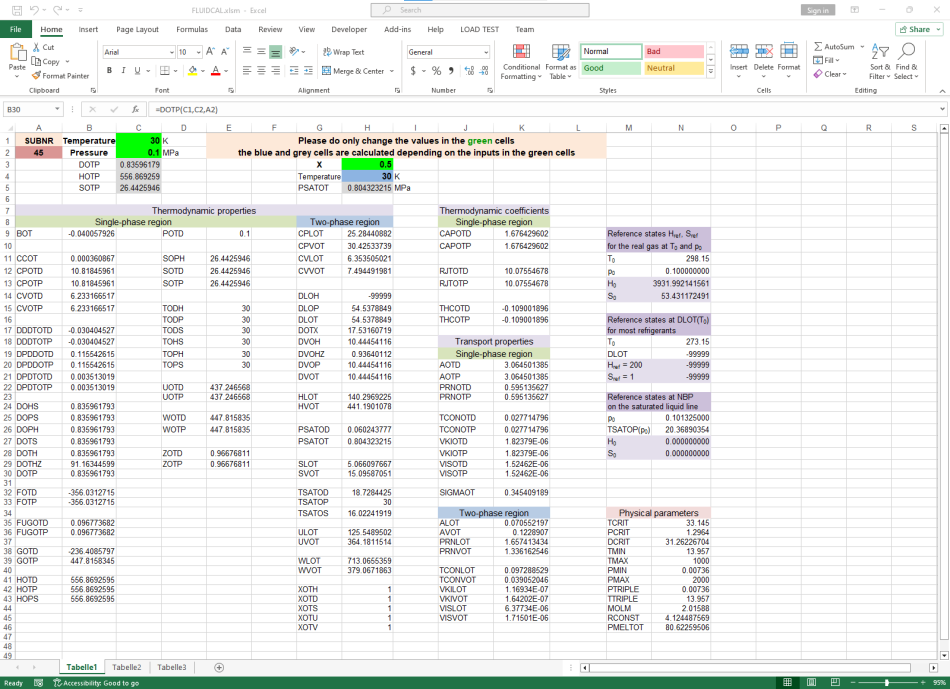The program FluidCal was developed for the calculation of thermodynamic properties from equations of state (fundamental equations of state in the form of the Helmholtz free energy) in research and for technical applications. For more than 95 substances, the software enables the calculation of 17 thermodynamic properties, three partial derivatives and for a number of substances (see the list in Table 1) also the calculation of dynamic and kinematic viscosity, thermal conductivity, Prandtl number, thermal diffusity and surface tension. All combinations of temperature T, pressure p, density ρ, specific enthalpy h, and specific entropy s can be selected as input variables for the calculations of thermodynamic properties.
Information about the use of the software under the various Windows operating systems and Excel versions as well as the integration of the available 32-bit or 64-bit Fortran DLL using Excel Add-Ins and 32-bit .NET DLL are given in Section 4 of this software description.
Detailed information about the current distribution channel by the engineering office Dr.-Ing. N. Kurzeja and its contact address can be found at the end of this website.
1. Equations of state for 96 substances covered by the Software FluidCal of version 2.4.6.0
In order to offer a calculation software for as many substances as possible, the FluidCal software package contains both the equations of state developed at the Chair of Thermodynamics of the Ruhr-University Bochum and equations of state by other authors. FluidCal is currently available for 96 substances, but will be continuously developed and can be expanded on demand at short notice.
When new reference equations of state are published for the substances integrated in FluidCal, they are immediately made available as an update for FluidCal, as happened, for example, for the important new equation of state for ammonia only a few days after its publication. With the current reference equations of state for hydrogen, hydrogen_short (CFD), ammonia and methanol and the associated transport equations for viscosity and thermal conductivity and the properties derived from them, FluidCal offers all the options for calculating the thermophysical properties of the hydrogen transport chain quickly and easily with the highest degree of accuracy.
Similary, the FluidCal version 2.4.6.0 can now be used to quickly and easily calculate the thermodynamic and partly also the transport properties of all new low-GWP refrigerants such as R1224yd(Z) (GWP = 0.88, ODP = 0.00012), R1233zd(E) (GWP = 1, ODP = 0.00034), R1234yf (new 2022) (GWP < 1, ODP = 0), R1234ze(E) (GWP = 1, ODP = 0), R1234ze(Z) (GWP = 4, ODP = 0), R1243zf (GWP < 1, ODP = 0), R1336mzz(Z) (GWP = 2, ODP = 0), R1336mzz(E) (GWP = 18, ODP = 0) and R-1132(E) (GWP=0.0056, ODP = 0), which are used in some of the heat pump or ORC cycle processes that are important in light of the climate crisis. In addition, the most recent optimized hydrogen_short equation was integrated for extremely fast CFD calculations of pipeline transport and storage.
Table 1 List of the fundamental equations of state for 96 substances integrated in FluidCal.
|
Acetone° |
Heavy water° |
Phenol° |
|
Ammonia**° (R717) |
Helium° |
Propane**° (R290) |
|
Argon**° |
Heptane*° |
Propylene**° (Propene, R1270) |
|
Benzene° |
Hexane*° |
Propylene Glycol* |
|
Butane**° (R600) |
Hexamethyldisiloxane° |
Propylbenzene |
|
Butene (1-Butene) |
1-Hexene |
R22**° |
|
Butene (cis-2-Butene)° |
Hydrogen**° |
R32**° |
|
Butene (trans-2-Butene)° |
Hydrogen_short(CFD)**° |
R41° |
|
Carbon dioxide**° (R744) |
Hydrogen chloride° |
R123**° |
|
Carbon monoxide° |
Hydrogen sulfide° |
R124**° |
|
Carbonyl sulfide° |
Isobutane**° (R600a) |
R125**° |
|
Chlorine |
Isobutene° |
R134a**° |
|
Chloroethene (vinyl chloride) |
Isohexane° |
R141b*° |
|
Cyclohexane° |
Isopentane° (R601a) |
R142b*° |
|
Cyclopentane° |
Krypton° |
R152a**° |
|
Cyclopropane"° |
Methane**° |
R245fa*° |
|
Decane*° |
Methanol**° |
R-1132(E) |
|
Decamethylcyclopentasiloxane° |
Methyl Diethanolamine |
R1224yd(Z)**° |
|
Decamethyltetrasiloxane° |
3-Methylpentane° |
R1233zd(E)**° |
|
1,2-Dichloroethane° |
Neon° |
R1234yf**° |
|
Diethylether° |
Neopentane° |
R1234ze(E)**° |
|
Diisopropyl ether" |
Nitrogen**° |
R1234ze(Z)° |
|
2,2-Dimethylbutane° |
Nitrous oxide° (R744a) |
R1243zf° |
|
2,3-Dimethylbutane |
Nonane*° |
R1336mzz(Z)° |
|
Dodecamethylpentasiloxane° |
n-Octane*° |
R1336mzz(E)**° |
|
n-Dodecane° |
Octamethylcyclotetrasiloxane° |
Sulfur dioxide° |
|
Ethane**° |
Octamethyltrisiloxane° |
Sulfur hexafluoride° |
|
Ethanol**° |
Oxygen**° |
Tetradecamethylhexasiloxane° |
|
Ethylbenzene° |
Pentane**° (R601) |
Tetrahydrofuran |
|
Ethylene**° (Ethene) |
n‑Perfluorobutane° |
Toluene |
|
Ethylene oxide° |
n‑Perfluorohexane° |
Water**° |
|
Fluorine° |
n‑Perfluoropentane° |
Xenon° |
* For substances marked with a star, in addition to the thermodynamic properties the
transport properties dynamic and kinematic viscosity can also be calculated.
** For substances marked with two stars, in addition to the dynamic and kinematic viscosity,
the thermal conductivity , the Prandtl number and the thermal diffusity can be calculated.
° For substances marked with ° , in addition the surface tension can be calculated.
" For substances marked with ", their equations were developed as part of a study on automated
fitting techniques for fluids of industrial interest. Because of their limited data sets they are less
accurate than normal reference equations of state optimized for one substance at a time.
The high-GWP refrigerants R11, R12, R23, R113, R116, R143a, R218 and R227ea can now only be integrated on special request.
If corresponding equations are available, the calculation of dynamic and kinematic viscosity, thermal conductivity, Prandtl number, thermal diffusivity or surface tension for substances not listed here can also be integrated or updated on request at short notice, as has currently been done for the transport properties of hydrogen, ammonia, methanol, ethanol, carbon dioxide, ethylene, propylene, R134a, R1234yf, R1234ze(E), R1224yd(Z), R1336mzz(E), R1233zd(E) or propylene glycol. The list with the respective current reference equations of state used in FluidCal, a list of directly available further equations of state and the references of the equations for the transport properties including surface tension is given on the website references.
2. Calculable thermodynamic and transport properties
Table 2 lists the calculable thermodynamic properties and Table 3 shows the calculable transport properties.
Table 2 Calculable thermodynamic properties.
|
Symbol |
Thermodynamic properties |
|
T |
Temperature |
|
p |
Pressure |
|
ρ |
Density |
|
h |
Specific enthalpy |
|
s |
Specific entropy |
|
cp |
Specific isobaric heat capacity |
|
cv |
Specific isochoric heat capacity |
|
w |
Speed of sound |
|
u |
Specific internal energy |
|
f |
Specific Helmholtz free energy, f = u ‒ Ts |
|
g |
Specific Gibbs free energy, g = h ‒ Ts |
|
f* |
Fugacity |
|
(∂p/∂T)ρ |
Partial derivative of pressure with respect to temperature at constant density |
|
(∂p/∂ρ)T |
Partial derivative of pressure with respect to density at constant temperature |
|
(∂ρ/∂T)p |
Partial derivative of density with respect to temperature at constant pressure |
|
μ |
Joule-Thomson coefficient, µ = (∂T/∂p)h |
|
δT |
Isothermal throttling coefficient, δT = (∂h/∂p)T |
|
κ |
Isentropic exponent, κ = – (v/p) (∂p/∂v)s |
|
B |
Second virial coefficient |
|
C |
Third virial coefficient |
Table 3 Calculable transport properties, see
footnotes of Table 1.
|
Symbol |
Transport properties |
|
η |
Dynamic viscosity |
|
ν |
Kinematic viscosity, ν = η / ρ |
|
λ |
Thermal conductivity |
|
Pr |
Prandtl number, Pr = ηcp/λ |
|
a |
Thermal diffusity, a = λ / ( ρ cp) |
|
σ |
Surface tension |
3. Input variables for the calculations
3.1 Thermodynamic properties
Fundamental equations of the Helmholtz free energy are formulated as a function of the temperature T and the density ρ. However, since other input variables are mostly used for technical calculations, the FluidCal software package contains functions with which for the combinations of the input variables (T,p), (T,h), (T,s), (p,ρ), (ρ,h), (ρ,s), (p,h), (p,s) and (h,s) the respective missing variables temperature T and density ρ are calculated for the homogeneous region as well as for the two-phase region.
For the most important input variables (T,p) and (T,ρ) it is possible to calculate directly all properties listed in Table 2. To avoid a complex number of functions, the program contains routines for the direct calculation of the temperature T and density ρ from all combinations of input values. Combined with these functions, all other properties listed in this table can be calculated depending on every possible combination of the input values. In the two-phase region, the program calculates the stable two-phase-system values for those properties.
On the vapour-liquid phase boundary the properties temperature, pressure or density can be used as input variables. The most important thermodynamic properties can be calculated directly on the saturated-liquid and saturated-vapour phase boundary depending on temperature. It is possible to calculate all other properties on the phase boundary by combining the functions of the saturated-liquid and saturated-vapour density and the corresponding functions for the calculation of the desired property as a function of temperature and density. If for a certain case the vapour pressure is given, functions for the calculation of the saturation temperature and the saturated-liquid and saturated-vapour density as a function of pressure are implemented. It is also possible to calculate directly the saturation temperature as a function of the saturated-liquid or saturated-vapour density.
3.2 Transport properties
The transport quantities can be determined both in the single-phase region as a function of the input variables (T,p) and (T,ρ) and directly on the phase boundary as well as a function of the saturation temperature. The surface tension can be calculated in the liquid region as a function of the input variable (T).
4. FluidCal DLL and Excel Add-In for calculating thermodynamic and transport properties
For the integration of the fundamental equations of state supplied by FluidCal in Windows based standard programs, the FluidCal software package contains the dynamic link library (DLL) FLUIDCAL.dll, optimized and built with the Intel Visual Fortran Compiler XE 15.0.7.287. The DLL provides more than sixty functions that allow the calculation of the thermodynamic properties listed above for the single-phase region, within the vapour-liquid two-phase region (if thermodynamically reasonable), and along the saturated-vapour and saturated-liquid phase boundary for all combinations of the input variables T, p, ρ, h and s.
In addition, the FluidCal software package contains an Excel Add-In file that allows a simple integration of the DLL into Microsoft Excel. Since the installation of the FluidCal Excel Add-In adds all functions exported with the FluidCal DLL to the standard Microsoft Excel function set, the desired thermodynamic and transport properties can be calculated directly in an Excel spreadsheet by calling the abbreviated name of the corresponding function with the required input variables. Thus, the density ρ for given values of temperature T and pressure p (and additionally the substance number SUBNR listed in the manual) is calculated from the function call DOTP. All functions can be called either by direct input of the formula listed in the manual into an Excel spreadsheet or very conveniently with the help of the function wizard of Microsoft Excel.

Calling the FluidCal function DOTP using the Excel function wizard

Entering the arguments for the function call DOTP for SUBNR 45 (Hydrogen)
A simple access to the function calls offered by FluidCal for the thermodynamic state variables and the transport variables is of course also possible within Excel via VBA scripts written for own purposes, which can then be called as macro.
Furthermore, the FluidCal software package contains an import library file (FLUIDCAL.lib) that allows to integrate the FLUIDCAL.dll into user specific Fortran and unmanaged Visual C++ applications.
All property functions of FluidCal are described in detail in the MANUAL FluidCal_x86/x64.PDF that is part of the software.
As an example, the following screenshot of the supplied reference spreadsheet FLUIDCAL.xlsm shows the results of the calculation of all the thermodynamic properties and transport properties (dynamic viscosity, kinematic viscosity, thermal conductivity, thermal diffusity, prandtl number and surface tension) for hydrogen (SUBNR = 45) for the temperature T = 30 K and the pressure p = 0.1 MPa. For T = 30 K, all thermodynamic properties on the saturated-liquid line and saturated-vapour line were calculated as well. The density for the user selectable vapour fraction x = 0.5 was also calculated within the two-phase region. With this density, all other properties that are defined within the two-phase region can be calculated at once. This Excel reference spreadsheet contains all the function calls provided by the FluidCal software package and can therefore be used as a quick and simple fluid properties calculator for any of the fluids currently available in FluidCal. Of course, a user specific Excel spreadsheet with the desired FluidCal function calls can be designed as well or any desired FluidCal function can be called within Excel via a user specific VBA script. Such VBA scripts could be successfully used, for example, for the calculation of the real gas properties of the fluids used in the evaluation of the tens of thousands of measured values in each case of the calibration and combustion runs for the determination of the gross calorific value of methane [J.Phys.Chem.Ref.Data 48, 043103 (2019)] instead of the ideal gas calculations that were common in the past.

Example screenshot of calculations of thermodynamic and transport properties of hydrogen (subnr = 45) with the software package FluidCal from within the reference Excel spreadsheet FLUIDCAL.xlsm.
The 32-bit version of FluidCal can be used on the 32-bit versions of Microsoft Excel (2003 ─ 2024/Microsoft 365) using the supplied Excel Add-Ins FLUIDCAL.xla (for Excel 2003) or FLUIDCAL.xlam (for Excel 2007 ─ 2024/Microsoft 365) on the various Windows operating systems [Windows 2000 or XP (32-bit), Windows Vista, 7, 8 and 10 (32-bit/64-bit)].
The FluidCal software is also available with a 64-bit DLL that can be integrated into the 64-bit versions of Excel 2010 ─ Excel 2024/Microsoft 365 on the 64-bit operating systems from Windows XP to Windows 11 using the supplied 64-bit Excel Add-In FLUIDCAL.xlam. Worksheets developed in a 32-bit version of Excel with FluidCal function calls can thus continue to be used in a 64-bit version of Excel without any changes.
In addition, a 32-bit .NET DLL of FluidCal is also available, which can be integrated into the .NET programming languages (Visual C#, Visual C++ or Visual Basic) of Microsoft Visual Studio.
The software FluidCal is not free of charge.
For universities and research institutions financed primarily by public funds, however, the FluidCal version for water according to the IAPWS-95 standard and the FluidCal version for hydrogen is distributed free of charge, if the software is used exclusively for teaching and research. Information about the open access for water see here, and about the open access for hydrogen see here.
The software package FluidCal is available for each of the substances listed in Table 1 in any desired combination and in any desired number of substances. In addition, a maintenance pack is now also available for the full version of FluidCal, which includes the automatic delivery of all FluidCal updates for one year.
The software FluidCal is distributed by the Engineering office Dr.-Ing. N. Kurzeja (Norbert.Kurzeja@rub.de).
Short version history:
Compared with the substance catalog of the widely used version 2.0.0.8 the software version of FluidCal was first increased to version 2.2.1.0 by the update of the equations of state for benzene, chlorine, hydrogen, hydrogen chloride, cyclohexane, cyclopentane, ethanol, ethylbenzene, helium, sulfur dioxide and 2,3 Dimethylbutane, the new inclusion of the equations of state for 1,2-dichloroethane, chloroethene (vinyl chloride), ethylene oxide, propylene glycol, methyl diethanolamine, 3-Methylpentane, 2,2-Dimethylbutane, n‑Perfluorobutane, n‑Perfluoropentane, n‑Perfluorohexane, R1234ze(E) and the equations of state of hexamethyldisiloxane, octamethylcyclotetrasiloxane, octamethyltrisiloxane, decamethyltetrasiloxane, dodecamethylpentasiloxane, tetradecamethylhexasiloxane, decamethylcyclopentasiloxane, which are particularly suitable for ORC processes. In addition, the range of functions of FluidCal has been extended by the calculation of the surface tension for almost all substances integrated in FluidCal as well as the thermal diffusivity and Prandtl number for many substances. With a simplification of the installation routine, the inclusion of 1-hexene and the further low-GWP refrigerants R1224yd(Z), R1233zd(E), R1234ze(Z), R1243zf, R1336mzz(Z), R1336mzz(E), the update of R1234yf, the transport properties of R1224yd(Z), R1336mzz(E), R1233zd(E), hydrogen, ammonia, methanol and ethanol, the inclusion of propylene glycol, the recent update of n-octane and of R245fa, as well as the direct calculation possibility for the transport properties on the phase boundary,